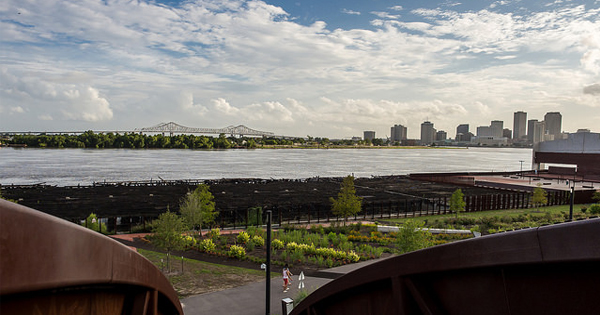
In the months after Katrina and the levee failure and flood, everyone had a vision as to how to rebuild the city. Brad Pitt’s Make It Right foundation envisioned a greener New Orleans, with the city’s shotgun houses redesigned and updated for the modern age. Local boosters envisioned a new BioDistrict to spur development of a bioscience industry. “Recovery czar” Ed Blakely envisioned the city as a new cargo gateway to Latin America and sub-Saharan Africa, something that would generate tens of thousands of port jobs.
Then there was former Mayor Ray Nagin, who spewed ideas like a malfunctioning wellhead. These included a 20-acre downtown Jazz Park that would celebrate the city’s musical heritage with performance spaces and a museum and also be home to a new city hall and courthouse. “The opportunity has presented itself for me to kind of go down in history as the mayor that guided the City of New Orleans through an incredible rebuild cycle,” he said at the time. (The Jazz Park never happened. Nagin eventually did go down in history, but as the first New Orleans mayor to be convicted for crimes committed in office.)
Everybody seemed to agree that at least 10 years would be needed for any of these visions for the new New Orleans to bear fruit. That seemed a long time away. Yet here we are. August 29, 2015 will mark a decade since the city nearly drowned, and so we’re heading into a season of revisiting projects with scorecard in hand to see which panned out and which didn’t.
Among the several high-profile notions that emerged was something called “Reinventing the Crescent.” The original master plan was vast and ambitious: to reclaim about six miles of riverfront, filling it with pathways for bikers and pedestrians and dotting the route with architectural wonders designed by Zaha Hadid, Frank Gehry, and other starchitects.
After an initial rollout of the plan amid drumrolls, the idea faded from public view, as did many other big ideas. (Where’s my port job?) But then about a year ago, with little fanfare, a segment of the project called Crescent Park opened to the public. It’s a geographically larger but conceptually smaller version of New York’s High Line, and like the Manhattan project, celebrates an industrial past while adapting it for modern purposes. Native plants grow in a tidy garden, through which walkways of rubbery asphalt follow the arcing outlines of the old rail spurs that once served the city’s wharves, now long gone. (Hargreaves Associates was the landscape architect.)
The park is only partially open right now, and it hasn’t garnered much attention. But when phase one is completed later this year—it awaits an ADA-compliant access point near the French Quarter—I’d be surprised if we don’t see those 1.4 miles of verdant riverfront appear in those travel magazine lists of places to visit in 2016.
Piety Wharf is the centerpiece of the newly completed stretch. It’s not as splashy as some of the plan’s earlier concepts, but David Adjaye Associates (with a master plan by local architects Eskew Dumez Ripple) created a modernist, low-key interpretation of the city’s port past. It’s a broad, open plaza jutting out over the river, occupying the footprint of a former riverfront warehouse. With a single concrete former firewall and weathered steel monoliths and platforms scattered about, it’s severe and spare, possessed of a Richard Serra sort of monumentality. It also has spectacular views of the city skyline.
The new park has come under attack from some quarters for being created mostly for tourists and accelerating gentrification of the adjacent neighborhood, once home to workers on the wharves. And it seems certain that this new park will lure more developers wanting to build condos within dog-walking distance, as happened with the High Line.
But I’ll admit it—Crescent Park has already become one of my favorite destinations in the city. New Orleans can be maddeningly ornate and complicated, but from the park it’s temporarily reduced to a soothing, accessible simplicity.
The best way to enter the park is via the Piety St. Bridge, a rusty arch of a footbridge over a floodwall and rail line. Also designed by Adjaye, it looks like a steampunk artifact from a forgotten industrial future. (Locally, it’s been dubbed the “rusty rainbow.”) It’s immensely Instagrammable, potentially as symbolic of the new New Orleans as the statue of Andrew Jackson doffing his hat in Jackson Square is of the old.
About 50 wooden steps lead to the crest of the bridge, where the views are partially obstructed by the bridge’s high, oxidized sides of Cor-Ten steel. Some of my friends insist this was a design flaw. I disagree, and find it an ingenious feature—the bridge constricts and controls your initial view of the river, so it’s first seen through a tarnished chasm.
Early one morning a few weeks ago, I climbed the bridge, and at the top looked over a river blanketed in dense, low-lying fog. The distant and spidery Crescent City Connection, the last bridge to cross the Mississippi River before it arrives at the Gulf, seemed to sit atop forest and fog, and at that moment a massive gray oil tanker silently slid past, as if scudding along atop clouds. It all felt very cinematic and Wes Andersonish.


